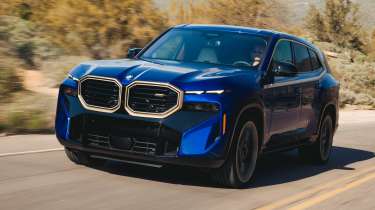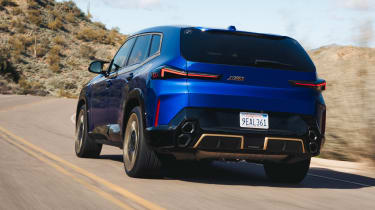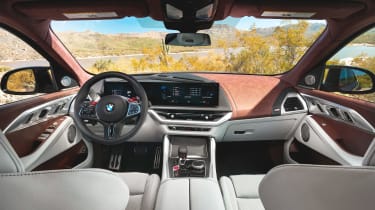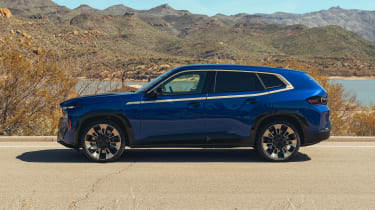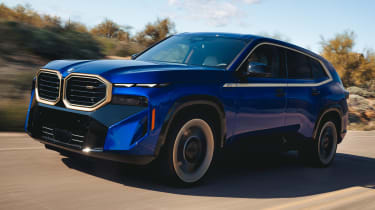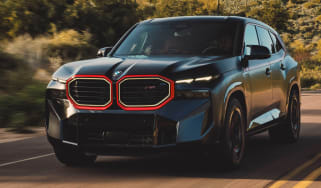BMW XM 2023 review
BMW M’s new flagship is its most powerful model ever, but it’s also the weakest driving experience of the current M range
The BMW XM is built on a solid business case. Luxury performance SUVs like the Porsche Cayenne, Bentley Bentayga and Lamborghini Urus are lucrative, and for BMW to make inroads into that market is a logical move.
A regular-brand BMW such as an X7 (or even an M version of a regular X-series car, such as an X6M) perhaps doesn’t quite have the cachet to entice the most image-conscious of buyers, and so badging this car as a bespoke M product makes sense, as does the outré design language. Adding to the prestige factor, it’s the most powerful M production car yet.
So while it might be unpalatable to some that the first bespoke M model since the ’70s M1 is a plug-in hybrid SUV, it’s a pragmatic product. What we must do, then, is judge the XM as both an SUV and as an M car. After all, this car’s slogan in the USA is ‘the fusion of X and M.’ It’s in the US where we’re driving the XM for the first time, on the freeways and canyon roads of Arizona. North America is expected to be one of the XM’s key markets, along with China, the Middle East and South Korea.
More reviews
Group tests
- Alpine A290 v Alpine A110 – how much DNA do they really share?
- Ariel Atom 4R v Caterham Seven ‘evo25’: power-to-weight heroes go head-to-head
- Aston Martin Vantage vs Audi R8 V10 RWD – back to basics
- Caterham Super Seven 600 v Super Seven 2000
- Levante v T1
- Corvette Stingray v Porsche Cayman GTS v Audi R8 RWD
- Great Ferrari hypercars driven: 288 GTO, F40, F50 and Enzo head-to-head
- Lamborghini Aventador Ultimae v Lamborghini Countach
- Lotus Emira v Morgan Plus Four – four-cylinder Brits go head-to-head
- Toyota GR86 v BBR Mazda MX-5: supercharged drop-top battles sports coupe
In-depth reviews
- Abarth 600e 2025 review – Italy gives the Alpine A290 something to worry about
- Alpine A110 review – distinctive, lightweight and unforgettable to drive
- Audi RS7 Sportback Performance review
- Bentley Continental R Mulliner: review, history and specs
- BMW 5-series review – is this still Munich’s anchor model?
- BMW 1-series review – Munich’s Audi A3 rival gains focus
Long term tests
- Abarth 695C Turismo Fast Fleet test – 10,000 miles in the Italian hot hatch
- Alfa Romeo Giulia Veloce Fast Fleet test – 7000 miles in the sharp Italian saloon
- Alpina B10: end of term report
- Alpina B10
- Ford Mustang GT
- Ford Mustang GT
- Ford Mustang GT
- Land Rover Defender 110 Fast Fleet test – 9000 miles in the go-anywhere SUV
- Maserati Ghibli Trofeo Fast Fleet test – 4000 miles in the Ferrari-powered saloon
- Mitsubishi Evo MR 340
Review
- New Aston Martin DBS 770 Ultimate review – 759bhp super-GT driven
- New Bentley Batur 2023 review – can it possibly be worth £1.65m?
- 2023 Chevrolet Corvette C8 Z06 review – the American 911 GT3?
- Kia EV6 GT-Line S prototype review – the EV that shows how it’s done
- BBR Supercharged Mazda MX-5 (ND) 2023 review – tuned 250bhp roadster driven
- MG4 Trophy 2023 review
Reviews
- Abarth 695 75 Anniversario edition 2024 review – a fitting send-off for Abarth’s hot supermini?
- Abarth 500e 2023 review
- AC Cobra 378 Superblower MkIV 2021 review – another V8 Cobra, but with a GM heart this time
- Acura Integra Type S 2024 review – a Honda Civic Type R with added restraint
- Alfa Romeo Giulia 2025 review – get one while you still can
- Alfa Romeo SZ: history, review and specs of an icon
- Alfa Romeo 1750 TBi
- Alpina B3 GT Touring 2025 review – a 190mph alternative to the BMW M3 Touring
As an SUV, it’s off to a bad start. Go to put your bags in the back and there’s a big boot with a flat floor and a flush load lip, but it’s very high, because of the Rubik’s Cube packaging requirements of an enormous battery pack and fuel tank. That also means there’s nowhere to stash the charging cable, so each XM comes with an overnight bag-style holdall in the boot to put it in.
Climb in the front and it feels curiously cramped: a lot of dashboard, not a lot of kneeroom. The seats feel a touch too high, even in their lowest setting.
It’s the opposite in the back: the XM’s interior concept is a driver-focused front cabin and luxurious ‘M Lounge’ rear, with a striking three-dimensional roof lining, epic legroom and decadently comfortable wraparound-cushioned rear seating.
Comfortable, that is, until you reach any bumpy or uneven bits of road. The steel springs and adaptive dampers give a ride that’s firm with a capital ‘F’ (and maybe a second F thrown in for good measure). Wheel size starts at 21 inches, with our test car wearing 22s; 23s are an option. Despite standard-fit electronically controlled dampers for the double-wishbone front, multi-link rear suspension, it’s simply too stiff.
And as an M car? Performance-wise, the XM packs some big numbers. The engine is a 4.4-litre twin-turbocharged V8, with an electric motor packaged together with the eight-speed ZF transmission.
A new unit rather than an adaption of the 4.4-litre V8 used in the M5 and M8, the XM’s engine generates 482bhp on its own. With the electric drive system lending a hand, total power and torque outputs are 644bhp and 590lb ft. An XM Label Red edition follows in autumn 2023, which will be the most powerful BMW road car ever with a pleasingly symmetrical 738bhp and 738lb ft. Weight distribution in the XM is symmetrical too, close to 50:50 front to rear.
The electric motor is the latest generation of BMW's eDrive units with nearly 200bhp and more than 300lb ft of torque, which easily moves the XM’s bulk around when it’s in EV mode.
The gigantic battery pack gives the XM a serious pure electric range, with 55 miles from a full charge and up to 87mph before the V8 kicks in. A long e-range was a target from the beginning, M head of engineering Dirk Hacker tells evo: ‘From my point of view, if you go with a hybrid car you need a real, usable electric range – a minimum electric range for a real offer.’ That’s partly why the kerb weight is so high: the XM needs a big battery because ‘for more than 80km [50 miles] electric range, for this dimension of car, you need some power,’ Hacker points out. Then, for the autobahn – and those headline performance figures – that new V8 comes into play.
Fast, then? The XM shifts, as you’d expect, but with 2.7 tonnes to haul around, it doesn't feel as eye-wideningly rapid as the power and torque figures might suggest.
Nor, as the kerbweight suggests, does it feel terribly agile. Hit a bump at medium speed and the body keeps moving for some time afterwards before settling; ask a high-speed direction change of the XM and it feels clumsy.
To their credit, the 48V active anti-roll bars do their job very well in most circumstances, keeping the big body spookily flat as we descend down a switchbacking series of canyon roads.
Standard-fit rear-wheel steering, the first on an M car, does help here too. It’s so subtle in its operation that you don’t necessarily feel what it’s up to as it virtually shortens the 3.1m wheelbase, or lengthens it at high speeds.
‘It’s good to use this system, not only for stability but also the turning circle,’ M’s head of engineering Hacker told us, adding: ‘But I don’t want to feel rear-wheel steering [in operation]. I want to have a very authentic steering behaviour, and for me it’s independent of what the technology behind it is – I wanted it to be quite subtle here.’
The XM’s XXL wheelbase (longer than an entire Toyota iQ) helps on the motorway too, where directional stability in fast curves is impressive. You sense the XM will be a stellar autobahn car, annoying wind noise around the mirrors aside.
Dynamically, however, the XM feels a curious mix overall: the active anti-roll software helps the XM corner with a commendably flat stance, yet the body can be upset by bumps and continue a lateral or diagonal motion after the bump has passed.
Yet at high speeds, big bumps are absorbed beautifully and longitudinal stability at autobahn speeds is stellar. And on the flipside, ride quality over minor bumps and surface imperfections at lower speeds is irritatingly fractious – no doubt largely due to the penny farthing-spec wheel diameters.
And conceptually it’s a curious mix too: it’s luxurious in the rear but comfort is compromised by the stiff low-speed ride and it feels cramped in the front; it has a very credible electric range but it would be difficult to describe this 2.7-tonne, enormous-batteried, 2710kg, 5.1m long, 4.4-litre V8-toting car as truly green, even if its official WLTP CO2 rating is well below 40g/km; it’s too awkwardly shaped of boot to be a truly practical SUV; and it’s too heavy and clumsy to be a truly enjoyable M car.
Subjectively, the BMW X6M is a more enjoyable driving experience for around £20k less than the XM’s circa £150k starting price; Aston Martin’s DBX, Bentley’s Bentayga and Lamborghini’s Urus are more expensive still, but they’re also more rewarding to drive.
The XM might stack up as a business case, but as a genuine M product, there’s little to enjoy here.
BMW XM specs
| Engine | V8, 4395cc, twin-turbo, plus 145kW electric motor |
| Power | 644bhp |
| Torque | 590lb ft |
| Weight | 2710kg (238bhp/ton) |
| 0-62mph | 4.3sec |
| Top speed | 168mph |
| Basic price | £148,060 |

